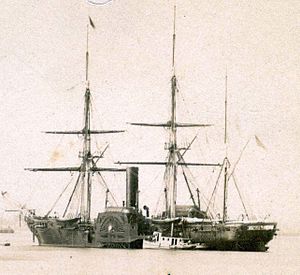USS Susquehanna (1847)

Susquehanna
|
|
| History | |
|---|---|
|
|
|
| Name: | USS Susquehanna |
| Builder: | New York Navy Yard |
| Laid down: | 1847 |
| Launched: | 5 April 1850 |
| Commissioned: | 24 December 1850 |
| Decommissioned: | 14 January 1868 |
| Fate: | Sold for scrap |
| General characteristics | |
| Type: | steam frigate |
| Tonnage: | 2,450 long tons (2,489 t) |
| Length: | 257 ft (78 m) |
| Beam: | 45 ft (14 m) |
| Draft: | 20 ft 6 in (6.25 m) |
| Depth of hold: | 26 ft (7.9 m) |
| Propulsion: | Steam engine, |
| Speed: | 10 knots (19 km/h; 12 mph) |
| Armament: |
|
USS Susquehanna, a sidewheel steam frigate, was the first ship of the United States Navy to be named for a river which rises in Lake Otsego in central New York and flows across Pennsylvania and the northeast corner of Maryland to empty into the Chesapeake Bay.
Her keel was laid down by the New York Navy Yard in 1847. She was launched on 5 April 1850; and was commissioned on 24 December 1850, Captain John H. Aulick in command.
After completing her trials, which she began in January 1851, the side-wheel frigate sailed on 8 June for the Far East to become flagship of the East India Squadron under the command of Commodore John H. Aulick. Aulick's orders included instructions to visit Japan and negotiate a treaty opening diplomatic relations with that country. However, before he could carry out his mission,he was forced to give up his command as result of quarrels during the first leg of his journey with Captain Franklin Buchanan, the captain of the flagship and due to an incident with a Brazilian diplomat on board.Susquehanna joined Commodore Matthew Perry's expedition as his flagship at Canton and entered Edo Bay with his squadron on 8 July 1853. After Perry had presented his demands and official letter from President Millard Fillmore to the Japanese government on 14 July, the American warships departed on 17 July. On 12 February 1854, Susquehanna returned with the squadron to Japan as part of Perry's show of force, resulting in the signing of the Convention of Kanagawa on 31 March 1854. The frigate departed Japanese waters on 24 March; and, after operating on the China coast, headed home via the Indian Ocean and the Cape of Good Hope. She arrived at Philadelphia, Pennsylvania, on 10 March 1855 and was decommissioned on 15 March.
...
Wikipedia
